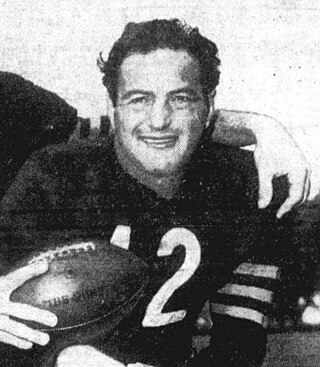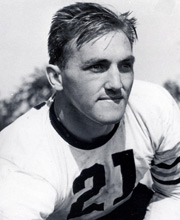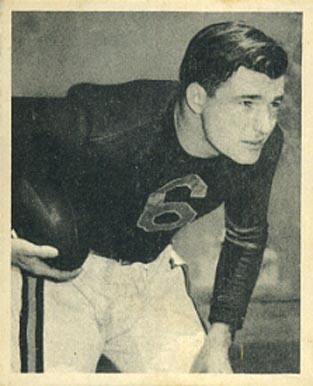Related Research Articles

The Chicago Bears are a professional American football team based in Chicago. The Bears compete in the National Football League (NFL) as a member club of the league's National Football Conference (NFC) North Division. The Bears have won nine NFL Championships, including one Super Bowl, and hold the NFL record for the most enshrinees in the Pro Football Hall of Fame and the most retired jersey numbers. The Bears have also recorded the second-most victories of any NFL franchise, only behind the Green Bay Packers, who they have a long-standing rivalry with.

Sidney Luckman was an American football quarterback who played for the Chicago Bears of the National Football League (NFL) from 1939 through 1950. During his 12 seasons with the Bears, he led them to four NFL championships in 1940, 1941, 1943, and 1946.

George Stanley Halas Sr., nicknamed "Papa Bear" and "Mr. Everything", was an American football end, coach, and executive. He was the founder and owner of the Chicago Bears of the National Football League (NFL), and served as his own head coach on four occasions. He was also lesser-known as a player for the New York Yankees of Major League Baseball (MLB). He is the namesake for the NFC Championship trophy.

Clyde Douglas "Bulldog" Turner was an American professional football player and coach in the National Football League (NFL). He was elected, as a player, to the College Football Hall of Fame in 1960 and the Pro Football Hall of Fame in 1966. He was also selected in 1969 to the NFL 1940s All-Decade Team.

Daniel John Fortmann was an American football guard and linebacker who played for the Chicago Bears in the National Football League (NFL). He played college football for the Colgate Red Raiders. Playing for Chicago from 1936 to 1943, he was selected as an All-Pro for seven consecutive years from 1937 to 1943. He was the Bears' team captain starting in 1940 and led the team to NFL championships in 1940, 1941, and 1943.

Eugene A. Ronzani was a professional football player and coach in the National Football League (NFL). He was the second head coach of the Green Bay Packers, from 1950 to 1953, and resigned with two games remaining in the 1953 season.

In American football, a T formation is a formation used by the offensive team in which three running backs line up in a row about five yards behind the quarterback, forming the shape of a "T".

Kenneth William Kavanaugh was an American football player, coach, and scout. He played professionally in the National Football League (NFL) for the Chicago Bears as an end from 1940 to 1950, except for three seasons during which he served in World War II. He led the league in receiving touchdowns twice, and is a member of the NFL 1940s All-Decade Team. He is the Bears' all-time leader in receiving touchdowns, with 50. He retired with the second most receiving touchdowns in NFL history and was the second to reach 50 touchdowns in NFL history.

James Warren Benton was an American football player. He played professionally in the National Football League (NFL) with the Cleveland / Los Angeles Rams and the Chicago Bears between 1938 and 1947. Benton was the first NFL receiver to gain more than 300 yards in a game, a record that stood for 40 years. He was selected for the National Football League 1940s All-Decade Team.
The 1942 NFL Championship Game was the tenth title game of the National Football League (NFL), played at Griffith Stadium in Washington, D.C., on December 13, with a sellout capacity attendance of 36,006.
The 1943 season was the Chicago Bears' 24th in the National Football League. The team failed to match on their 11–0 record from 1942 and finished at 8–1–1, under temporary co-coaches Hunk Anderson and Luke Johnsos. On the way to winning the Western Division, the Bears were, yet again, denied a chance at an undefeated season by the defending champion Redskins in Washington. The Bears had their revenge in the NFL title game and defeated the Redskins at Wrigley Field to claim their sixth league title. It was their third championship in four years, establishing themselves as the pro football dynasty of the early 1940s.
The 1936 season was the Chicago Bears' 17th in the National Football League and 14th season under head coach George Halas. The team was able to improve on their 6–4–2 record from 1935 and finished with a 9–3 record. The team also finished in second place in the Western Division behind the Green Bay Packers. After week 10, the Bears were tied with the Packers in first place with identical 9–1 records, having split their season series. However, the club swooned at the end of the year, losing their last two games on the road to Detroit and the Cardinals. Green Bay went on to easily defeat the Boston Redskins and win the NFL title.
The 1937 Chicago Bears season was their 18th regular season completed in the National Football League. The Bears started the season fast, winning their first five games, three of them on the road. After a tie to the Giants and a loss to the Packers, the Bears finished the season strong, winning their last four games. The team was second in scoring offense, behind Green Bay, and led the league in scoring defense.
The 1939 Chicago Bears season was their 20th regular season completed in the National Football League. They finished second in the Western Division with an 8–3 record. The Bears started the season well, winning 4 of their first 5 games. However, two mid-season losses to New York and Detroit cost them the Division to Green Bay. The Packers went on to win the NFL championship.

Donald John Kindt, Sr. was an American defensive back and halfback who played nine seasons from 1947 to 1955 for the Chicago Bears in the National Football League (NFL). Kindt played college football for the University of Wisconsin Badgers primarily as a halfback from 1943 to 1946, missing the 1944 and half of the 1945 season because of World War II. He was the starting halfback for the Badgers for most of his college career.

Edgar John "Eggs" Manske was a professional American football player who played six seasons in the National Football League (NFL). Manske was the last college player to play without a football helmet. Manske played in two NFL championship games with the Chicago Bears, including the historic 1940 NFL Championship Game, a 73–0 victory over the Washington Redskins.
Ruey Young Bussey was a professional American football quarterback for the Chicago Bears of the National Football League (NFL). An all-star during his only season in the NFL, Bussey was killed in action during World War II. He was the only Bears player to die in the war.
The 1940 NFL Championship Game, sometimes referred to simply as 73–0, was the eighth title game of the National Football League (NFL). It was played at Griffith Stadium in Washington, D.C., on December 8, with a sellout capacity attendance of 36,034.
The 1940 National Football League All-star Game (December) was the professional football league's third all-star game. The game pitted the Chicago Bears, the league's champion for the 1940 season, against a team of all-stars. The game was played on Sunday, December 29, 1940, at Gilmore Stadium in Los Angeles, California before an overflow crowd of 21,000, with members of the Stanford and Nebraska football teams also in attendance; the two were scheduled to play in the Rose Bowl, with Nebraska using the All-Star Game to research the Bears' T formation, which was being used by Stanford head coach and former Bears assistant Clark Shaughnessy. The Bears defeated the All-Stars by a score of 28–14.
The 1942 National Football League All-Star Game (December) was the National Football League's fifth all-star game. The game pitted the Washington Redskins, the league's champion for the 1942 season, against a team of all-stars. The game was played on Sunday, December 27, 1942, at Shibe Park in Philadelphia, Pennsylvania in front of 18,671 fans. The All-Stars defeated the Redskins by a score of 17–14.
References
- ↑ "1944 Chicago Bears Game Log". Pro Football Reference. Retrieved April 20, 2020.
- ↑ "1944 Chicago Bears Game Log". Pro Football Reference. Retrieved April 20, 2020.
- 1 2 3 4 5 Boden, Chris (May 29, 2017). "A History Of The Bears Who Served During World War II". NBC Sports. Archived from the original on January 8, 2018. Retrieved March 21, 2020.
- ↑ Schmidt, Raymond (2001). Football's Stars Of Summer: A History Of The College All-Star. Scarecrow Press. p. 73.
- ↑ Schmidt, Raymond (2001). Football's Stars Of Summer: A History Of The College All-Star. Scarecrow Press. p. 74.
- ↑ Schmidt, Raymond (2001). Football's Stars Of Summer: A History Of The College All-Star. Scarecrow Press. p. 75.
- ↑ Schmidt, Raymond (2001). Football's Stars Of Summer: A History Of The College All-Star. Scarecrow Press. p. 77.
- ↑ "1944 Chicago Bears Draftees". Pro Football Reference. Retrieved April 28, 2020.
- 1 2 3 4 5 "The 1944 Chicago Bears". Steelers UK. Retrieved April 29, 2020.
- ↑ Hybl, Dean (December 6, 2011). "Remembering the NFL On December 7, 1941". Sports Then and Now. Retrieved April 26, 2020.
- 1 2 3 4 "1944 Chicago Bears Statistics & Players". Pro Football Reference. Retrieved March 21, 2020.
- ↑ Anton, Toddy; Nowlin, Bill (2013). When Football Went To War. Triumph Books. p. 112-113.
- ↑ Anton, Toddy; Nowlin, Bill (2013). When Football Went To War. Triumph Books. p. 23.
- ↑ Algeo, Matthew (2013). Last Team Standing: How The Steelers And The Eagles—"The Steagles"—Saved Pro Football During World War II. Chicago Review Press. p. 210. ISBN 978-0306815768.